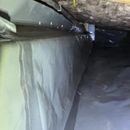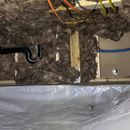Is it OK to staple crawlspace poly to the mud sill? And other questions on crawlspace vapor barrier practices.
I just had my semi-ventilated crawlspace insulated and vapor-barriered in the Seattle, WA area where we have temperate weather (Climate Zone 4 coastal). We are doing the minimum ventilation allowable for a ventilated crawlspace by code (~ 1 sqft ventilation per 1500 sqft floor space).
The contractors brought my 10mm poly vapor barrier up the walls like I asked, but stapled it to the mud sill or, in some cases, to the rim joist (pictures attached). They did not fasten at all to footings, and they did not tape all overlapping seams — and, where they did, they used regular duct tape. How important is this, and is regular ol’ grey duct tape a reasonable choice here or should I have them re-tape / tape over it with something better?
I’m wondering 1) if the stapling to mud sill & rim joist will slowly introduce enough moist air to these wood components to cause rot or mold, 2) if taping seams and fastening to footings makes much difference in crawlspace humidity [and what the best way to fasten to footings is … I assume I shouldn’t fasten to the post, just the concrete footing/pier?], and 3) how much of a difference in crawlspace humidity it will make to use 1-bys to batten the vapor barrier to the cement instead (while bringing the poly some number of inches below the mud sill). The cost and time to have them do this would not be inconsiderable, so I’d like to understand potential impacts before having them make changes.
Does anyone have suggestion on resources that might help me understand the tradeoffs here? Thanks!
GBA Detail Library
A collection of one thousand construction details organized by climate and house part











Replies
finePMW,
Could you describe a bit more about what the wall consist of? What is behind the poly, what is against the concrete stem-walls?
As general comment: vapour-barriers work as a percentage of the area covered, so leaving a small part of a wall or floor exposed has a negligible effect on their performance
Thanks Malcom,
Yes, good point! The crawlspace has a dirt floor. The foundation is 50% new and 50% existing.
For the new bits: the rim joist is treated lumber with sill gasket + caulk under mud sill for air seal, and the stem wall is concrete with exterior tar coating, 2" dual-foil-backed polyiso adhered to that, and metal flashing over that. Rim joist has Tyvek Commercial D WRB, 1.5" rock wool comfortbatt exterior insulation, 3/4" rain screen, and cement fiber Hardie plank cladding.
For the existing bits: the rim joist is old untreated cedar with no sill gasket or air seal at the mud sill, and the stem wall is bare concrete. Some of the existing rim joist was given exterior comfortbatt rock wool insulation and rainscreen, but most was simply Tyvek HomeWrap (or Commercial D in places) + cement Hardie plank cladding.
Re: seams and perimeter sealing, I guess I was thinking vapor pressure might still drive moisture through the seams, but is that not really a considerable factor in crawlspace humidity?
Re-looking at my photos, I think they only fastened to the rim joist (staples), and only in some places ran the plastic up along the rim joist some (but only fastened at the sill below)
finePMW,
I would prioritize avoiding moisture and rot problems in the existing sill-plate over trying to make the vapour-barrier continuous. So stopping the poly shy of the sill-plate and sealing it to the stem-wall. You can use caulking to seal the sill-plate.
Duct tape on the seams? Bunch of puds! I would use red or blue Tuck Tape, if it is available south of the border.
Agreed. Puds indeed! So it sounds like there's strong reason to believe the vapor barrier attached to the mud sill is a no-no for moisture concerns, is that right?
We definitely have the 3m red stuff, but I've never personally seen the vaunted blue Tuck Tape that I've heard so much about from our neighbors to the North.
Thanks!
Deleted
finePNW,
I'm not entirely sure. It depends on how much moisture ends up behind the poly. It's better if there is no path for that moisture to make it's way to the sill-plate, but it may be a theoretical concern that never materializes.
Thanks! It can be difficult for me to discern theoretical from tried-and-true / best practices, so I appreciate the update!
And are you saying that air sealing the mud sill is still important in my crawlspace despite being ventilated because the air that gets through can bring moisture directly into contact with the mud sills?
finePNW,
No. I should have said: If you want to air-seal the mud-sill...
Gotcha. Thanks!